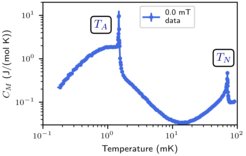Small but packs a punch: Electro-nuclear Transition in YbRh2Si2
Experiments show that the heavy fermion compound YbRh2Si2 undergoes a spectacular electro-nuclear phase transition into a modulated magnetic state at a temperature as low as 1.5 mK. In a just published paper, an international team of scientists from the UK (Royal Holloway University of London) and Germany (Goethe University Frankfurt, MPI-CPfS Dresden) demonstrated that in YbRh2Si2, at TA = 1.5 mK, the tiny nuclear moments profoundly change an electronic magnetic state formed at a much higher temperature TN = 70.5 mK.

In general the magnetic properties of solids are entirely determined by the electrons. In magnetic materials these electrons carry large magnetic moments μe, which can orient themselves below a critical temperature to form a magnetically ordered state. Depending on whether the moments are aligned parallel to each other or in different directions, this state is known as ferromagnetic (FM), like e.g. in permanent magnets, or antiferromagnetic (AFM).
In contrast, the magnetic moment μI of an atomic nucleus is about a thousand times smaller than the electronic moment. Accordingly, these tiny nuclear magnetic moments usually have no influence on the macroscopic properties of a solid. But Yb is distinguished by a large hyperfine interaction which couples nuclear and electronic magnetism. And YbRh2Si2 is a heavy fermion compound in which local electronic moments are entangled with conduction electrons by the Kondo effect. So how might nuclear magnetism enter the game?
In a just published paper, an international team of scientists from the UK (Royal Holloway University of London) and Germany (Goethe University Frankfurt, MPI-CPfS Dresden) demonstrated that in YbRh2Si2, at TA = 1.5 mK, the tiny nuclear moments profoundly change an electronic magnetic state formed at a much higher temperature TN = 70.5 mK. This was shown by heat capacity measurements with remarkably high-resolution and within a challenging temperature range of 180 µK - 80 mK (see figure). This kind of measurements requires a precise determination of the temperature which is very difficult to achieve below 10 mK. Thus, these experiments were only possible because the scientific team developed and strongly improved over the last years a specialized measurement technique known as current sensing noise thermometry. It has set new standards for such kind of measurements.
How can the tiny nuclear magnetic moments profoundly change the state of the three orders of magnitude larger electronic moments? Previous measurements showed that in YbRh2Si2 the electronic order established at TN is weak AFM, with a tiny ordered moment, a few thousandths of μe. Furthermore this state is extremely fragile, being strongly influenced by an unusually weak magnetic field. Thus with increasing field a parallel electronic moment develops up to about one tenth μe. Ultimately at a modest field, corresponding to the tiny magnetic energy of only around 2 mK, the AFM order is fully suppressed.
By contrast, at TA = 1.5 mK, a new strongly antiferromagnetic electronic state appears, driven by nuclear magnetism.
The low temperature heat capacity shown in the figure arises from the nuclear moments of the two Yb isotopes, 171Yb and 173Yb. The hyperfine interaction between the nuclear moments and the electrons favors states with large magnetic polarization of both the electrons and the nuclear moments. At TA this interaction drives a nuclear assisted transition into a state in which the electronic magnetism appears to be both stronger, around one tenth μe, and spatially modulated. The polarization of the nuclear moments results in a spectacular signature in their heat capacity, as shown in the figure.
Nuclear magnetism is only carried by the isotopes 171Yb and 173Yb, with total abundance of only 30%, while the remaining isotopes have no nuclear moment. Nevertheless, the gain in magnetic polarization energy of these tiny Yb nuclear moments packs enough punch to drive the formation of a new electronic state.
In addition to the rich magnetic behavior reported in this work, YbRh2Si2 exhibits unconventional superconductivity below 10 mK. The distinct magnetic states above and below TA may host different superconducting order parameter, adding a new twist to the fundamental question of the interplay between magnetism and superconductivity. Perhaps the most interesting open question is whether YbRh2Si2 is a spin triplet crystalline topological superconductor, a class of materials long sought after as a companion to superfluid 3He and because of their technological significance.












